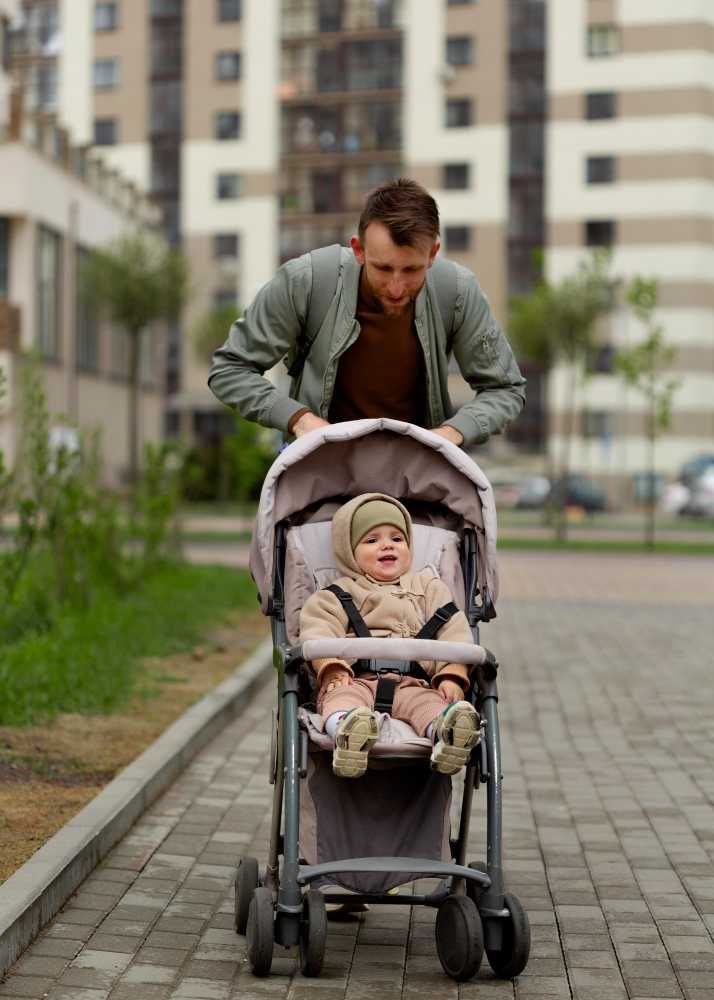When Can Baby Sit in Front Facing Stroller? Key Considerations

Strollers are crucial for parents since they make navigating the world with their babies easier. Thankfully, front-facing strollers come in various shapes, sizes, and designs, ensuring that there is a suitable option available to meet your specific needs and offer a secure and comfortable experience for your little one.
But, one common question amongst new parents is when can baby sit in front facing stroller? Although strollers make traveling with your toddler convenient, knowing the ideal time for your baby to sit in a front-facing stroller is paramount. To ensure your baby’s comfort and safety, below are key considerations when deciding when your baby can begin using a front-facing stroller and some tips for a smooth transition:
What Is a Forward-Facing Stroller?
A forward-facing stroller is a type of baby stroller designed to allow your child to face in the direction of travel, typically looking forward. When your baby is seated in a forward-facing stroller, they are oriented towards the world in front of them rather than facing the person pushing the stroller.
Forward-facing strollers are commonly used once a baby has developed enough neck and upper body strength to support themselves in an upright position and is curious about the world around them. These strollers come in various styles, sizes, and designs, offering features that can enhance the comfort and convenience of both the child and the parent or caregiver.
Benefits of Front-Facing Strollers
Front-facing strollers have gained popularity among parents for several good reasons. Before delving into when a baby can sit in front facing stroller, let’s look at the range of benefits front-facing strollers offer you and your baby:
Better Engagement with the Environment
Probably the greatest benefit of front-facing strollers is that they provide babies with a broader and more stimulating view of their surroundings. Babies are naturally curious, and facing forward allows them to explore the world around them. They can watch people, animals, and objects, stimulating their cognitive and sensory development.
Enhance Learning
Since babies sit facing forward, they have the opportunity to observe and learn from their environment. They can see different colors, shapes, and movements, which can be both entertaining and educational. This exposure to the external world helps foster their curiosity and learning as they grow.
Better Interaction
Front-facing strollers offer you and your baby a unique opportunity for interaction and bonding. Your baby can hear your voice and engage in conversations with them, which is crucial for their emotional and cognitive development. Moreover, you can comfort your baby when needed and engage in playful interactions, contributing to a strong emotional bond. Make the most of this time to talk, sing, and play with your baby while you explore the world together.
Boost Self-Confidence
As babies become more independent, front-facing strollers offer them a chance to explore their surroundings at their own pace. This transition to independent exploration is a crucial part of a child’s development. Facing forward, your baby can take in the world while still being under your watchful eye, helping them build self-confidence.
Enhance Cognitive and Sensory Development
Front-facing strollers expose babies to a wide range of sensory stimuli, from the changing scenery to the feel of the breeze and the sounds of the outdoors. These experiences help babies learn to process and interpret sensory information, contributing to their cognitive development. They become more aware of their environment and how it responds to their actions and behaviors.
Comfort and Entertainment
Many front-facing strollers come equipped with features designed to enhance a baby’s comfort and entertainment. These features can include adjustable seats that allow the baby to sit up or recline, sunshades to protect from the sun, and toy bars to keep the baby engaged during the ride. The ability to face forward allows babies to access and interact with these features more easily.
Secure Harness System
Front-facing strollers typically come with a secure harness system, often a five-point harness, which ensures the baby is safely strapped in. This safety feature provides peace of mind to parents, knowing that their child is securely seated during the stroller ride.
Types of Front-Facing Strollers
Front-facing strollers come in various types, each designed to cater to different needs and lifestyles. These stroller types offer distinct features and functionalities to accommodate the preferences of both parents and the comfort of their children. Here are some common types of front-facing strollers:
1. Infant Car Seat Adapter
Infant car seat adapter strollers are designed to accommodate infant car seats, allowing you to seamlessly transfer your baby from the car to the stroller without disturbing their slumber. These strollers typically feature a car seat attachment system, ensuring that the car seat securely clicks into the stroller frame.
The primary benefit of an infant car seat adapter stroller is convenience. Infant car seat adapter strollers are an excellent choice for parents of newborns since they eliminate the need to wake a sleeping baby when transitioning from the car to the stroller. Additionally, it provides a lightweight and portable option for quick errands or short outings.
These strollers can be a suitable option if you want a hassle-free way to transport your newborn, especially during the first few months when they usually sleep frequently. Infant car seat adapter strollers are also a practical and portable solution for short trips.
2. Convertible Baby Stroller
Convertible baby strollers are versatile and adaptable and feature a reversible seat, allowing you to switch between front-facing and rear-facing positions. These strollers may also offer multiple recline options, adjustable canopies, and compatibility with infant car seats.
The key benefit of a convertible stroller is its flexibility. A convertible baby stroller can grow with your child, accommodating their changing needs as they develop. This stroller type is suitable for parents who want a long-lasting, multi-functional solution that can adapt to their child’s age and preferences.
These strollers are ideal for parents who value versatility and intend to use a single stroller for an extended period, from infancy through toddlerhood. It’s also suitable for those who prioritize face-to-face interaction with their baby when needed.
3. Jogging Stroller
Jogging strollers are built for active parents who want to maintain their fitness routines while taking their child along. They have large, air-filled tires, excellent suspension systems, and a stable design. Some models offer adjustable tracking for optimal straight-line performance.
Jogging strollers provide a smooth and comfortable ride for both the baby and the parent. They allow parents to stay active while enjoying outdoor adventures with their child. The front-facing position in a jogging stroller lets the baby engage with the surroundings while the parent gets exercise.
Jogging strollers are ideal for parents who enjoy jogging or off-road activities and want a solution that can keep up with their active lifestyle. As such, jogging strollers can be a perfect option if you want to share your passion for the outdoors with your child.
4. Double Baby Stroller
Designed to accommodate two kids, double strollers come in two main configurations: side-by-side (double) and front-back (tandem). Some double stroller models offer the flexibility to have one seat rear-facing and the other facing forward.
Double strollers are essential for parents with twins or siblings close in age. They provide a convenient way to transport both children at once, making outings more manageable. Front-facing options in double strollers allow both children to enjoy the view and the surroundings.
It is ideal for parents of twins or siblings with a small age gap who need a practical and efficient solution for transporting multiple children.
5. Travel Systems
Travel systems feature an infant car seat and a stroller that can be used interchangeably. Travel system strollers are designed to accommodate the car seat, ensuring a smooth transition from car to stroller and vice versa.
Travel systems offer a seamless way to transport your baby from the car to the stroller without waking them. They are versatile and convenient, allowing you to use the stroller for various purposes while maintaining the safety and comfort of the infant. They are an excellent choice for new parents looking for an adaptable solution for their child’s transportation needs, especially during the first year when infant car seats are necessary.
Each type of forward-facing stroller caters to specific needs and preferences, so when deciding when a baby can sit in front facing stroller, it’s essential to choose one that suits your lifestyle and your baby’s needs. Whether you’re looking for convenience, flexibility, fitness, or a solution for multiple children, there’s a front-facing stroller designed to meet your specific requirements.
When Can Baby Sit In Front Facing Stroller?
When determining when a baby can sit in front facing stroller, you should take several key factors into account to ensure their safety, comfort, and overall well-being. Here are the key factors to consider:
Age and Developmental Readiness
To determine when baby can sit in front facing stroller, consider their age and developmental stage. Most stroller manufacturers recommend using a front-facing position for babies at least 6 months old. At this age, many infants have developed enough neck and core strength to support their head and upper body. However, individual development can vary, so it’s essential to observe your baby’s specific progress.
Head and Neck Control
Ensure that your baby can hold their head up steadily and independently. Babies typically develop this skill around 4 to 6 months of age, making it a crucial factor for front-facing stroller use.
Weight and Size
Most strollers come with specific height and weight requirements for using the front-facing position. Refer to the manufacturer’s weight and size recommendations for the specific stroller model. Ensure that your baby falls within the weight and size limits specified for front-facing use.
Posture and Comfort
Pay attention to your baby’s posture when seated in the stroller. They should be able to sit comfortably without slouching or slumping forward. Ensure that the stroller provides a well-padded, comfortable seat with proper cushioning to prevent discomfort and pressure points.
Transitioning to a Front-Facing Stroller
Transitioning your baby to a front-facing stroller is an exciting milestone, but it should be done gradually and with care to ensure your baby’s comfort and safety.
Observe Your Baby’s Readiness
Before making the switch, observe your baby’s behavior and comfort level. Do they show an interest in the world around them? Are they trying to sit up on their own or showing improved head and neck control? These are signs that your baby may be ready to face forward in a stroller.
Start with Short Walks
When you decide to transition to a front-facing stroller, start with short walks to allow your baby to get used to the new position. Monitor their comfort and engagement with the environment. If your baby appears restless or uncomfortable, consider switching back to a rear-facing position for a while.
Adjust the Seat Recline
Most front-facing strollers come with adjustable seat recline options. Ensure that your baby’s stroller seat is set to a comfortable and safe recline angle. This is especially important for younger babies who may still need some head and neck support.
Use a Well-Fitting Harness
Always use the stroller’s harness system to secure your baby in the front-facing position. Ensure that the harness fits snugly but not too tightly. Regularly check the harness to make sure it’s in good condition and functioning correctly.
Safety Tips for Using a Front-Facing Stroller
Once you’ve determined when baby can sit in front facing stroller, you need to prioritize their safety when using it. Here are some important safety tips to keep in mind:
Use the Five-Point Harness
Most front-facing strollers come with a five-point harness system, which includes straps over the shoulders, around the waist, and between the legs. Make sure to use this harness properly to secure your baby in the stroller.
Check the Stroller’s Brakes
Before each use, check the stroller’s brakes to ensure they are in good working order. This is crucial for keeping the stroller stationary when needed.
Keep an Eye on Your Baby
Even though your baby is facing forward, it’s essential to maintain visual contact and supervision. Be attentive to your baby’s needs and ensure they are comfortable throughout the ride.
Avoid Using a Front-Facing Stroller for Newborns
Front-facing strollers are not suitable for newborns. Always use a rear-facing stroller, a stroller with a reversible seat, or a bassinet attachment for newborns, as these provide better support for their fragile head and neck.
Be Mindful of Weather Conditions
Consider the weather conditions when using a front-facing stroller. Protect your baby from harsh sun, wind, rain, and cold by using appropriate accessories like sunshades, rain covers, and blankets.
Follow the Manufacturer’s Guidelines
Read and follow the manufacturer’s guidelines for your specific stroller model. These guidelines will provide you with essential information on the proper use and maintenance of your stroller.
Alternatives to Front-Facing Strollers
While front-facing strollers have their advantages, it’s important to note that they may not be the best choice for every situation. There are alternatives to consider based on your baby’s age and needs:
Rear-Facing Strollers
Rear-facing strollers are ideal for newborns and younger babies who still need head and neck support. They allow you to maintain eye contact with your baby and offer a comfortable and secure position for your little one.
Strollers with Reversible Seats
Some strollers come with reversible seats that allow you to switch between rear-facing and front-facing positions. These versatile strollers provide flexibility as your baby grows and reaches different developmental milestones.
Baby Carriers
Baby carriers, such as slings, wraps, and structured carriers, offer a close and intimate way to carry your baby, keeping them snuggled against your chest. These are great options for newborns and infants and allow for plenty of interaction and bonding.
The Bottom Line
When it comes to deciding when a baby can sit in front facing stroller, it’s essential to consider their age, developmental milestones, and overall comfort. The safety and well-being of your child should always be the top priority. Transitioning to a front-facing stroller is an exciting step in your baby’s development, as it allows them to engage with the world and bond with you in a new way. By following the above guidelines, you can ensure a smooth and safe transition for both you and your little one.





